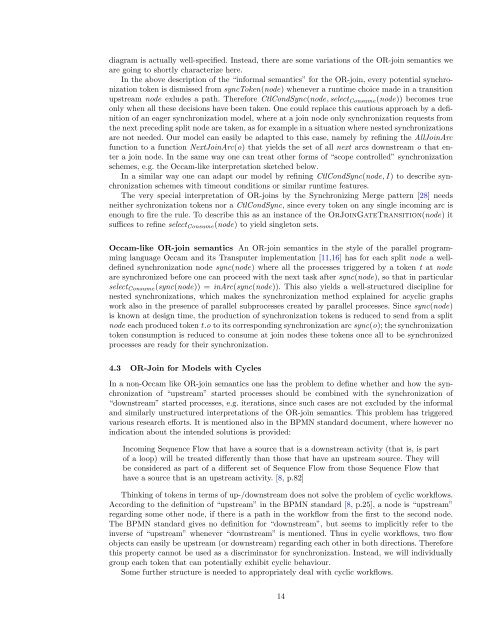BPMN and Beyond Business process modelling notation, workflow ...
BPMN and Beyond Business process modelling notation, workflow ...
BPMN and Beyond Business process modelling notation, workflow ...
Create successful ePaper yourself
Turn your PDF publications into a flip-book with our unique Google optimized e-Paper software.
diagram is actually well-specified. Instead, there are some variations of the OR-join semantics we<br />
are going to shortly characterize here.<br />
In the above description of the “informal semantics” for the OR-join, every potential synchronization<br />
token is dismissed from syncToken(node) whenever a runtime choice made in a transition<br />
upstream node exludes a path. Therefore CtlCondSync(node, select Consume (node)) becomes true<br />
only when all these decisions have been taken. One could replace this cautious approach by a definition<br />
of an eager synchronization model, where at a join node only synchronization requests from<br />
the next preceding split node are taken, as for example in a situation where nested synchronizations<br />
are not needed. Our model can easily be adapted to this case, namely by refining the AllJoinArc<br />
function to a function NextJoinArc(o) that yields the set of all next arcs downstream o that enter<br />
a join node. In the same way one can treat other forms of “scope controlled” synchronization<br />
schemes, e.g. the Occam-like interpretation sketched below.<br />
In a similar way one can adapt our model by refining CtlCondSync(node, I ) to describe synchronization<br />
schemes with timeout conditions or similar runtime features.<br />
The very special interpretation of OR-joins by the Synchronizing Merge pattern [28] needs<br />
neither sychronization tokens nor a CtlCondSync, since every token on any single incoming arc is<br />
enough to fire the rule. To describe this as an instance of the OrJoinGateTransition(node) it<br />
suffices to refine select Consume (node) to yield singleton sets.<br />
Occam-like OR-join semantics An OR-join semantics in the style of the parallel programming<br />
language Occam <strong>and</strong> its Transputer implementation [11,16] has for each split node a welldefined<br />
synchronization node sync(node) where all the <strong>process</strong>es triggered by a token t at node<br />
are synchronized before one can proceed with the next task after sync(node), so that in particular<br />
select Consume (sync(node)) = inArc(sync(node)). This also yields a well-structured discipline for<br />
nested synchronizations, which makes the synchronization method explained for acyclic graphs<br />
work also in the presence of parallel sub<strong>process</strong>es created by parallel <strong>process</strong>es. Since sync(node)<br />
is known at design time, the production of synchronization tokens is reduced to send from a split<br />
node each produced token t.o to its corresponding synchronization arc sync(o); the synchronization<br />
token consumption is reduced to consume at join nodes these tokens once all to be synchronized<br />
<strong>process</strong>es are ready for their synchronization.<br />
4.3 OR-Join for Models with Cycles<br />
In a non-Occam like OR-join semantics one has the problem to define whether <strong>and</strong> how the synchronization<br />
of “upstream” started <strong>process</strong>es should be combined with the synchronization of<br />
“downstream” started <strong>process</strong>es, e.g. iterations, since such cases are not excluded by the informal<br />
<strong>and</strong> similarly unstructured interpretations of the OR-join semantics. This problem has triggered<br />
various research efforts. It is mentioned also in the <strong>BPMN</strong> st<strong>and</strong>ard document, where however no<br />
indication about the intended solutions is provided:<br />
Incoming Sequence Flow that have a source that is a downstream activity (that is, is part<br />
of a loop) will be treated differently than those that have an upstream source. They will<br />
be considered as part of a different set of Sequence Flow from those Sequence Flow that<br />
have a source that is an upstream activity. [8, p.82]<br />
Thinking of tokens in terms of up-/downstream does not solve the problem of cyclic <strong>workflow</strong>s.<br />
According to the definition of “upstream” in the <strong>BPMN</strong> st<strong>and</strong>ard [8, p.25], a node is “upstream”<br />
regarding some other node, if there is a path in the <strong>workflow</strong> from the first to the second node.<br />
The <strong>BPMN</strong> st<strong>and</strong>ard gives no definition for “downstream”, but seems to implicitly refer to the<br />
inverse of “upstream” whenever “downstream” is mentioned. Thus in cyclic <strong>workflow</strong>s, two flow<br />
objects can easily be upstream (or downstream) regarding each other in both directions. Therefore<br />
this property cannot be used as a discriminator for synchronization. Instead, we will individually<br />
group each token that can potentially exhibit cyclic behaviour.<br />
Some further structure is needed to appropriately deal with cyclic <strong>workflow</strong>s.<br />
14
















